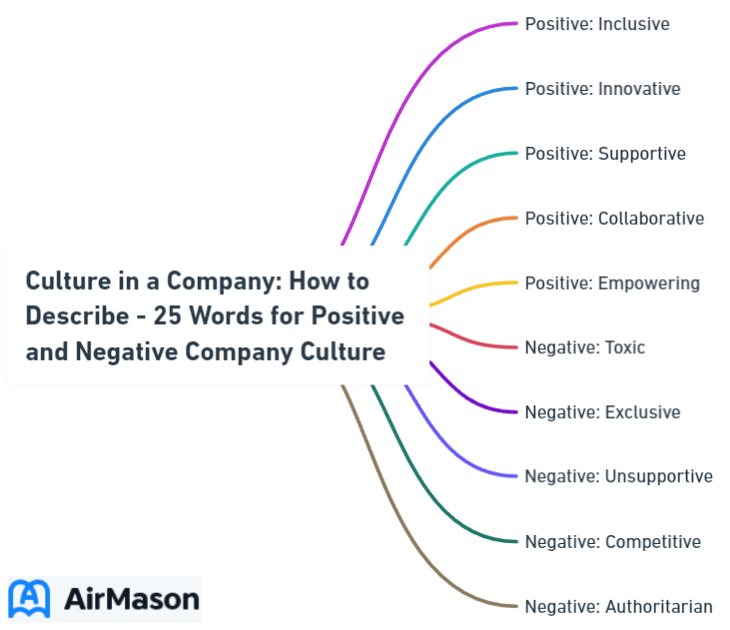
In today’s competitive business landscape, a thriving company culture is the secret ingredient that sets successful organizations apart. A strong, well-defined culture not only attracts top talent but also cultivates employee satisfaction, engagement, and productivity. But what exactly does a great company culture look like, and how can organizations describe and assess their own culture? In this blog post, we will take a closer look at culture in a company: how to describe it using 25 words that paint a vivid picture of both positive and negative company culture elements, helping businesses better understand and communicate their work environment.
Key Takeaways
- This article provides 25 words to accurately describe both positive and negative company culture.
- Strategies for improving company culture involve defining core values, fostering open communication, promoting diversity & inclusion, recognizing employee achievements and continuously evaluating/adapting.
- Company culture has a significant impact on business success as it can either boost or hinder engagement, productivity & profitability. Successful examples include Google, Apple & Amazon.
25 Words to Describe Company Culture
Company culture, or organizational culture, represents the values and environment within an organization that drive employee performance and satisfaction. Having a good understanding of your company’s culture is key to developing a place where current and potential employees would like to join. Describing this culture is likewise paramount in achieving this goal. In fact, culture is one aspect that can provide valuable insights into how a company functions beyond its financial statements or market presence when used to describe company culture. So, how would you describe your company culture?
We will delve into 25 words that organizations can use to describe their company culture, encompassing both positive and negative facets.

An Organization’s Culture
An organization’s culture is the bedrock upon which its values, beliefs, and practices are built. It serves as the guiding force that shapes how employees interact, make decisions, and pursue common goals. This intangible yet powerful aspect of any institution permeates every level, influencing everything from day-to-day operations to long-term strategic planning. A positive and inclusive organizational culture fosters a sense of belonging among employees, leading to increased productivity and innovation. Conversely, a toxic or misaligned culture can stifle creativity and hinder progress, potentially resulting in turnover and diminished performance. Therefore, understanding, nurturing, and aligning with an organization’s culture is pivotal for both individual success and the overall health of the institution.
Positive Words for Company Culture
When looking for positive words to describe company culture, consider the following examples:
- Agile
- Collaborative
- Inclusive
- Innovative
- Empathetic
- Transparent
- Motivating
- Flexible
- Supportive
A rewarding company culture fosters an environment where employees feel valued, motivated, and connected to the organization’s mission.
A respectful and welcoming culture, for instance, can create a collaborative and supportive work environment, boosting productivity and employee morale. A challenging workplace culture, on the other hand, encourages employees to expand their knowledge and take calculated risks.
Promoting these positive qualities can help organizations cultivate a positive workplace culture, which can allure top talent and foster enduring employee loyalty.
Agile
An agile company culture is characterized by adaptability, quick decision-making, and responsiveness to change. In such an environment, employees can balance their work and personal lives, leading to increased productivity and satisfaction.
Agile cultures enable:
- Greater responsiveness to external changes
- Long-term success
- Cultivating autonomy, innovation, and flexibility
- Constructing a thriving work environment
- Empowering employees to make decisive contributions to the organization’s growth
Collaborative
A collaborative company culture encourages teamwork and leverages employees’ individual abilities to achieve shared goals. A collaborative culture, which promotes open communication and sets clear expectations, fosters a sense of unity and collective triumph. This environment enhances employee satisfaction, engagement, and productivity, driving the long-term success of the organization.
Strong collaboration also helps in breaking down silos, improving communication across departments, and fostering innovation.
Inclusive
An inclusive company culture, also known as an inclusive culture, values diversity, equity, and belonging, creating an environment where employees from various backgrounds feel valued and supported. Research has shown that companies with diverse workforces are more likely to outperform their industry peers, making inclusivity a critical factor in business success.
Cultivating a culture of acceptance, open dialogue, and celebration of differences results in a more supportive ambiance that benefits both employees and the company.
Innovative
An innovative company culture encourages creativity, experimentation, and continuous improvement, driving growth and competitiveness. Promoting a culture of risk-taking and innovative problem-solving enables organizations to stay abreast of industry trends and seize new opportunities.
An innovative culture also fosters employee engagement and satisfaction, as workers feel empowered to contribute their unique ideas and perspectives to the company’s success.
Empathetic
An empathetic company culture values understanding, compassion, and emotional intelligence, leading to stronger relationships and better conflict resolution. Fostering a culture of empathy can lead to a more supportive work environment, making employees feel heard, valued, and respected. This, in turn, boosts employee satisfaction, engagement, and productivity, driving long-term success and loyalty. When employees feel like they are genuinely cared for, the overall atmosphere becomes more positive and conducive to growth.
Empathetic cultures also contribute to creating a psychologically safe space where employees feel comfortable discussing challenges and seeking support when needed.
Transparent
A transparent company culture is built on open communication, honesty, and accountability, fostering trust and loyalty among employees. Keeping employees abreast of company operations, strategies, and goals can instill a sense of shared purpose and ownership. Transparency also helps to prevent misunderstandings, miscommunication, and workplace conflicts, leading to a more harmonious and productive work environment.
Consequently, a transparent culture contributes to increased employee engagement, satisfaction, and retention.
Motivating
A motivating and engaging company culture inspires and energizes employees to achieve their best performance and contribute to the organization’s success. Setting clear expectations, offering meaningful work, and acknowledging employee achievements can lead to an environment where employees feel engaged and committed.
A motivating culture:
- Fosters a sense of camaraderie and unity among team members
- Boosts morale and productivity
- Helps companies outperform their competitors and attract top talent
Companies with motivating cultures, such as Google, Apple, and Amazon, have been shown to experience the benefits of being a great company.
Flexible
A flexible company culture supports work-life balance, remote work, and adaptable work arrangements, leading to higher employee satisfaction and retention. Offering employees the freedom to manage their workload and personal commitments can result in a more engaged and committed workforce. Flexible cultures also promote greater diversity and inclusion, as they accommodate the needs of employees with varying responsibilities and circumstances.
In an increasingly connected and globalized business landscape, a flexible culture can help organizations attract and retain top talent while staying agile and competitive.
Supportive

A supportive company culture provides resources, guidance, and encouragement for employee growth and development, fostering a sense of loyalty and commitment. Investing in employee development can ensure a skilled, adaptable, and engaged workforce.
A supportive culture also demonstrates that the company values its employees and is committed to their long-term success, leading to increased job satisfaction and retention. Companies with supportive cultures, such as Zappos and Warby Parker, have been praised for their employee-centric approach and commitment to fostering a positive work environment.
Negative Words for Company Culture
While positive company culture traits contribute to a thriving work environment, it’s also crucial to recognize and address negative aspects that can lead to employee dissatisfaction, disengagement, and turnover. Negative words to describe company culture include:
- biased
- cliquey
- disengaged
- hostile
- micromanaged
- rigid
- stressful
- siloed
- outdated
- unsupportive
Identifying and addressing these undesirable aspects can help organizations cultivate a more inclusive, supportive, and engaging work environment, fostering long-term success and employee loyalty.
Biased
A biased company culture perpetuates discrimination, favoritism, and unfair treatment, undermining trust and collaboration. This type of culture can lead to a lack of diversity and inclusion, stifling innovation and creativity.
Addressing bias in the workplace involves fostering open communication, promoting diversity and inclusion, and implementing policies that ensure fair treatment for all employees. By eliminating bias, organizations can create a more inclusive and supportive work environment where employees feel valued and respected.
Cliquey
A cliquey company culture is characterized by the formation of exclusive groups and social barriers, leading to feelings of isolation and disconnection among employees. This type of culture can hinder collaboration, communication, and the sharing of ideas, ultimately impacting the organization’s success and growth.
To combat a cliquey culture, organizations should promote open communication, inclusivity, and team-building activities that encourage all employees to interact and work together.
Disengaged
A disengaged company culture is marked by:
- Lack of enthusiasm, commitment, and passion
- Poor performance and high turnover
- Employees feeling disconnected from the company’s mission and values
- Decreased productivity and job satisfaction
To address disengagement, organizations can focus on creating a positive work environment, providing meaningful work, and recognizing and rewarding employees for their efforts.
Hostile
A hostile company culture is characterized by conflict, aggression, and negativity, negatively impacting employee well-being and productivity. In such an environment, employees may feel threatened, anxious, and demoralized, leading to decreased job satisfaction, increased stress, and even health issues.
To improve a hostile culture, organizations should:
- Foster open communication
- Promote a positive work atmosphere
- Implement policies and procedures that address and prevent bullying, harassment, and other negative behaviors.
Micromanaged
A micromanaged company culture stifles autonomy, creativity, and initiative, leading to employee disengagement and resentment. In a micromanaged culture, employees may feel that their abilities are not trusted, and their input is not valued. This can result in decreased job satisfaction, motivation, and loyalty.
To avoid micromanagement, organizations should empower employees to make decisions, encourage creativity and innovation, and provide support and guidance when needed.
Rigid
A rigid company culture can have negative effects, including:
- Hindering growth and adaptability
- Stifling employee creativity and innovation
- Decreasing job satisfaction
- Reducing employee engagement
It is important for companies to foster a culture that encourages change and innovation to thrive in today’s fast-paced business environment.
To address rigidity, organizations should be open to change, embrace new ideas and technologies, and foster a culture of continuous improvement and growth.
Stressful

A stressful company culture promotes excessive workload and pressure, leading to burnout, health issues, and decreased job satisfaction. In a stressful work environment, employees may feel overwhelmed and unable to manage their responsibilities effectively. This can lead to increased absenteeism, decreased productivity, and higher turnover rates.
To alleviate workplace stress, organizations should focus on promoting work-life balance, providing support and resources for employees, and encouraging open communication about workload and expectations as employees work.
Siloed
A siloed company culture isolates departments and teams, resulting in communication breakdowns, inefficiencies, and lack of collaboration. In a siloed culture, employees may feel disconnected from other teams and departments, leading to missed opportunities and slower decision-making.
To break down silos, organizations should promote open communication, encourage interdepartmental collaboration, and foster a sense of shared purpose and goals.
Outdated
An outdated company culture clings to old practices, technologies, and mindsets, impeding progress and competitiveness. In an outdated culture, employees may feel frustrated by inefficient processes, lack of innovation, and resistance to change. This can lead to decreased job satisfaction, employee disengagement, and difficulty attracting and retaining top talent.
To modernize an outdated culture, organizations should be open to new ideas, embrace new technologies, and continuously evaluate and update their practices and processes.
Unsupportive
An unsupportive company culture neglects employee needs, growth, and well-being, leading to dissatisfaction and disloyalty. In an unsupportive culture, employees may feel that their personal and professional needs are not being met, leading to decreased job satisfaction, engagement, and loyalty.
To create a more supportive culture, organizations should provide resources and opportunities for employee growth and development, and foster a sense of value and appreciation among employees.
How to Assess Your Company Culture

Assessing your company culture is an important step in understanding its current state and identifying areas for improvement. Various methods can be employed to evaluate company culture, such as employee surveys, focus groups, and observation. By gathering feedback and insights from employees, organizations can gain a deeper understanding of their culture’s strengths and weaknesses, and develop targeted strategies to address specific areas of concern.
In assessing company culture, considering both positive and negative aspects, as well as the alignment between the organization’s core values, mission statement, and the employees’ actual workplace experience, is crucial. By taking a comprehensive and honest look at your company’s culture, you can identify areas for improvement and take the necessary steps to create a more engaging, supportive, and successful work environment.
New World Companies
New world companies represent a paradigm shift in the business landscape. These enterprises are characterized by their innovative approaches to industry norms, often leveraging cutting-edge technologies and disruptive business models. Unlike traditional corporations, new world companies prioritize agility, adaptability, and a forward-thinking ethos. They thrive in an interconnected global economy, capitalizing on digital platforms and data-driven strategies to reach wider audiences. Moreover, new world companies often place a strong emphasis on sustainability, social responsibility, and ethical practices, reflecting a broader awareness of their impact on the environment and society. This transformative wave of companies is reshaping industries, challenging established norms, and leading the way into a future where innovation and purpose-driven business are paramount.
Strategies for Improving Company Culture
Improving company culture requires a multifaceted approach that addresses both the positive and negative aspects identified through assessment. Some key strategies for enhancing company culture include:
- Defining and communicating core values
- Setting clear expectations
- Fostering open communication
- Promoting diversity and inclusion
- Recognizing employee achievements
Implementing these strategies can help organizations cultivate a more positive, engaging, and supportive work environment that allures top talent, retains employees, and propels business success.
Remember, enhancing company culture is a continuous process demanding regular evaluation, adaptation, and commitment from all organizational levels.
The Impact of Company Culture on Business Success

A positive company culture has a profound impact on a company’s success, as it influences employee satisfaction, engagement, and productivity. Research has shown that companies with a strong company culture are more likely to outperform their competitors, attract and retain top talent, and achieve long-term growth and success.
On the other hand, a negative company culture can lead to disengaged employees, high turnover rates, and reduced productivity and profitability. Recognizing and addressing the negative aspects of company culture can help organizations cultivate a more inclusive, supportive, and engaging work environment, fostering enduring success and employee loyalty.
Cultivating a Positive Work Environment
Cultivating a positive work environment is essential for fostering productivity, employee satisfaction, and overall organizational success. Creating a positive work environment begins with open communication and a culture of respect among colleagues. When team members feel valued and heard, it fosters a sense of belonging and encourages them to contribute their best efforts. Moreover, recognizing and celebrating achievements, both big and small, reinforces a positive atmosphere. Encouraging work-life balance and providing opportunities for personal and professional growth also play pivotal roles in maintaining a positive work environment. Ultimately, investing in a culture that promotes positivity not only enhances employee well-being but also leads to increased innovation and a stronger, more cohesive team.
Real-World Examples of Successful Company Cultures
Examples of successful company cultures can be seen in organizations like Google, Apple, and Amazon, which have built strong organizational cultures that attract top talent, retain employees, and drive business success. These companies are known for their unique and positive workplace cultures that emphasize innovation, collaboration, and employee well-being.
Google, for example, is renowned for its flexible, creative, and enjoyable work environment, which has contributed significantly to its success. By investing in employee development and fostering a culture of collaboration and innovation, Google has created a workplace where employees are engaged, satisfied, and committed to the company’s mission. These real-world examples serve as a valuable reminder of the importance of cultivating a strong and positive company culture for long-term business success.
Summary
In conclusion, company culture has a profound impact on employee satisfaction, engagement, and productivity, as well as overall business success. By understanding and describing their company culture, organizations can create a thriving work environment that attracts top talent, retains employees, and drives long-term growth. Assessing and improving company culture requires a commitment to defining core values, fostering open communication, promoting diversity and inclusion, and recognizing employee achievements. By learning from real-world examples of successful company cultures and implementing targeted strategies, organizations can create a more inclusive, supportive, and engaging work environment that fosters success and employee loyalty.
Frequently Asked Questions
What is an example of a company culture?
Company culture can be exemplified through customer focus, look and feel, dress code, office layout, perks program and social calendar. These elements help define the atmosphere and image of an organization, as well as shape the rest of its culture.
How do you show a company culture in a job description?
Company culture involves a set of shared values, ethics and beliefs that define the atmosphere and operations of an organization. When writing a job description, include how the position aligns with the company’s values to attract candidates who share similar values and align with the company’s culture, and provide a sense of the larger picture in regards to their work and how it contributes to the mission, goals and values.
What is a good company culture like?
A good company culture involves open communication, mutual respect, shared goals, and a commitment to employee growth and development – all of which create an environment that supports and appreciates employees.
What is the importance of understanding and describing company culture?
Understanding and describing company culture is essential for employee satisfaction, engagement, and productivity, thus creating a workplace that attracts and retains employees.
How can I assess my company’s culture?
Assessing your company’s culture can be done by using employee surveys, focus groups, and observation. This will allow you to gain an understanding of the strengths and weaknesses of your culture.